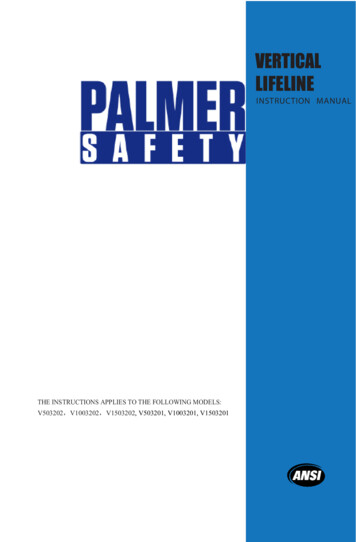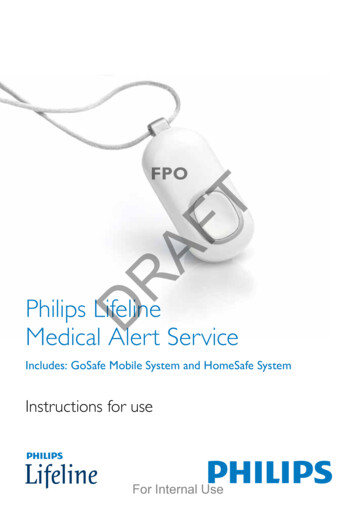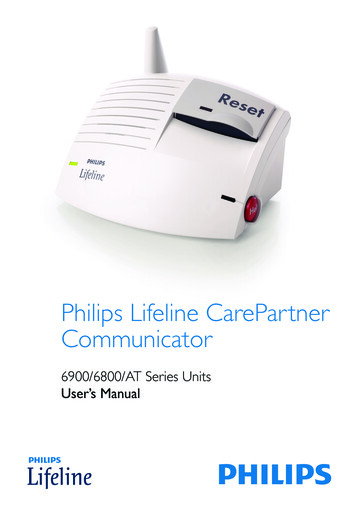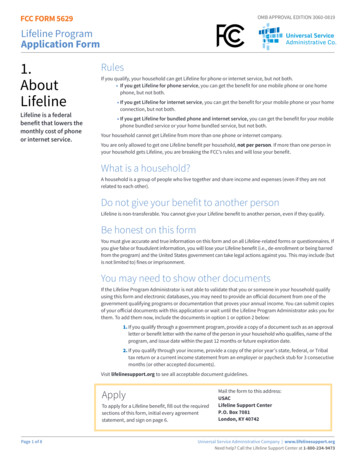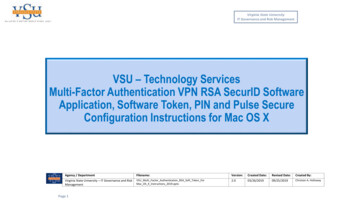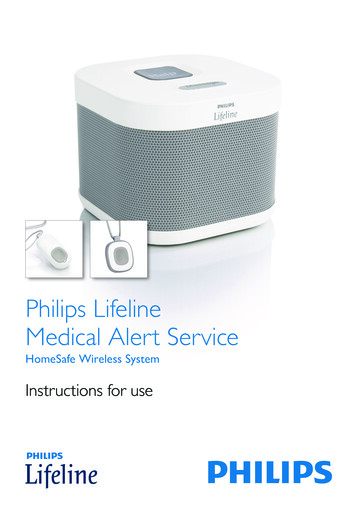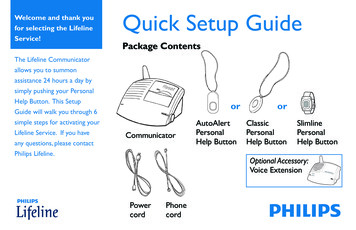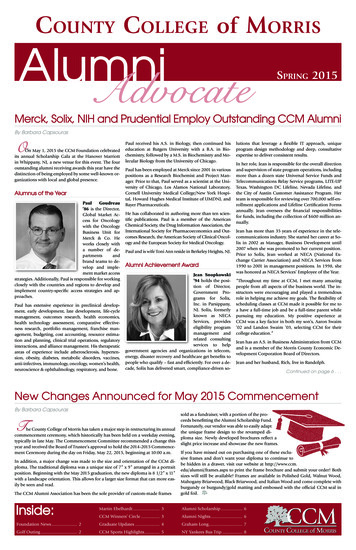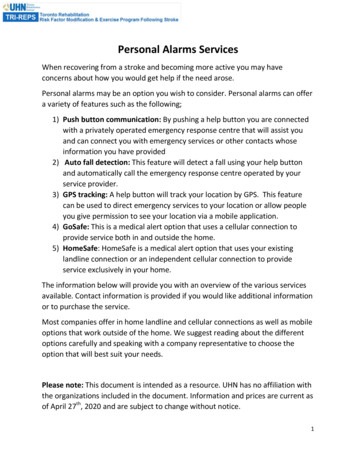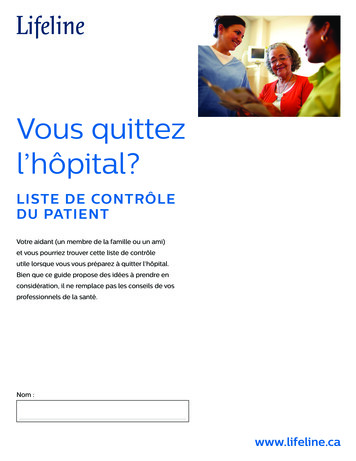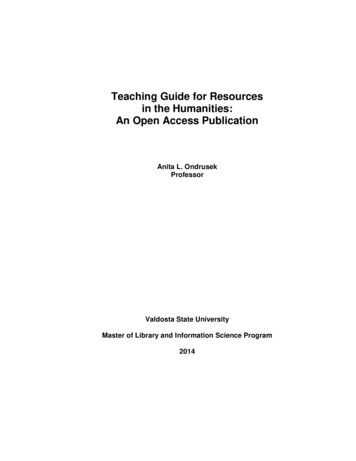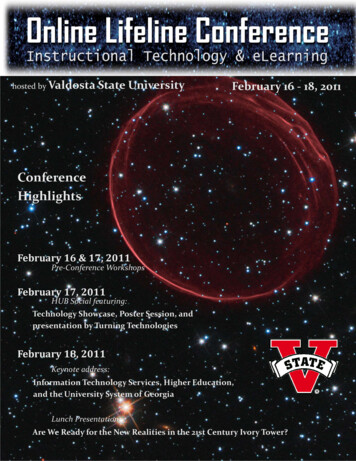
Transcription
hosted by ValdostaState UniversityFebruary 16 ‐ 18, 2011ConferenceHighlightsFebruary 16 & 17, 2011Pre‐Conference WorkshopsFebruary 17, 2011HUB Social featuring:Technology Showcase, Poster Session, andpresentation by Turning TechnologiesFebruary 18, 2011Keynote address:Information Technology Services, Higher Education,and the University System of GeorgiaLunch Presentation:Are We Ready for the New Realities in the 21st Century Ivory Tower?
Table of ContentsKeynote Address.3Concurrent Sessions .4‐9Conference at a Glance (schedule) .10Featured Presentation .11Conference Commons (vendor tables) .12Hub Social .13Technology Showcase.14Posters .15Pre‐Conference Workshops .16 ‐ 17Presenters and Co‐presenters.18 ‐ 192012 Conference Announcement .19Conference Sponsors.202011 Online LifelineConference CommitteeAnita OndrusekAssociate Professor, MLISValdosta State UniversityJon SizemoreDirector, eLearningValdosta State UniversityJulie HalterDirector, Continuing EducationValdosta State UniversityHolly PeaglerInstructional Technology SpecialistValdosta State UniversityBecky MurphyAssistant Director, Employee &Organizational DevelopmentValdosta State UniversityPage 2
Table of ContentsKeynote AddressAt a Crossroads: Learning Styles, Communities of Practice andDistance EducationThis presentation examines the intersection betweenpeople, technology and learning and challenges theaudience to think differently about the futureinteraction between the three. How do peoplefundamentally learn? How do they learn incommunities throughout their life? How doestechnology and distance education in particularsupport learning? In an interactive and engagingdiscussion, Dr Carver fosters a conversation about thefuture of education in Georgia and the critical role thatonline and distance education will play.About the SpeakerDr. Curtis A. Carver Jr.Vice Chancellor and Chief Information OfficerUniversity System of GeorgiaCurtis A. Carver Jr. was appointed the Vice Chancellor and Chief Information Officer ofUniversity System of Georgia on May 1, 2010. Prior to his appointment, he served atWest Point in a number of positions including Vice Dean of Education, Vice Dean forResources, Associate Dean for Academic Computing, Program Director, and Professor ofComputer Science. As a military officer, his career spanned 27 years with assignmentsincluding Company Commander, Battalion Operations Officer, Division Deputy G6, and military mentor.His military deployments included Afghanistan and Iraq where he served as a strategic mentor and as amember of the NATO‐Iraq team.Dr. Carver plays an active role in shaping the national agenda in accreditation, technology, andeducation. He has served as a member of a number of governing bodies or executive boards including theComputer Science Accreditation Board (CSAB), Computer Accreditation Commission (CAC), CIOExecutive Summit, and Federal Information Assurance Conference (FIAC), and Federal InformationSecurity, System, Education and Awareness (FISSEA) board. He is a senior level member in the ACM andIEEE professional societies.Dr. Carver’s research interests remain diverse with contributions in the fields of information assurance,adaptive hypermedia, computer science education, simulation, and decision‐support systems. Withininformation assurance, Dr Carver explored the use of intelligent agents for intrusion response, creating agame‐based environment for learning computer security, and empowering students to educate andprotect student‐based organizations.Page 3
Table of ContentsConcurrent Sessions I9:00am ‐ 9:45amTeaching the Hybrid; How to Enhance the Students' Experiences Outside theTraditional ClassroomJill A. Geltner, Assistant Professor, Valdosta State UniversityCharmaine Caldwell, Assistant Professor, Valdosta State UniversityKatharine Adams, Assistant Professor, Valdosta State UniversityLarry Hilgert, Associate Professor, Valdosta State UniversityRoom 240Hybrid courses are becoming more commonplace in universities nationwide. Hybrid courses providestudents with the face‐to‐face contact of the traditional classroom while providing the flexibility of an onlinecourse. Learning to combine these modes of delivery can be challenging for both new and experiencedinstructors. This panel presentation will outline some successful methods used by professors in theDepartment of Psychology and Counseling that can enhance teaching in any subject area. Topics to beaddressed include: online assessment, how to build effective online and hybrid learning communitiesthrough use of the discussion board, creating experiential activities to compliment course content, andonline live supervision using Wimba. Attendees will leave with practical, useful ideas to implement intocourses immediately. The audience will also be invited to share successful strategies in teaching within anonline and hybrid format.SafeAssign: Preventing Plagiarism is Just the BeginningSharon Gravett, Assistant Provost, Valdosta State UniversityVincent Spezzo, Instructional Technology Specialist, Valdosta State UniversityJonathan Sizemore, Director, eLearning, Valdosta State UniversityRoom 243SafeAssign is a plagiarism prevention tool offered as an integrated part of the Blackboard CourseManagement System at no additional cost. This presentation will start with an introduction to theSafeAssign tool and points out the major advantages and disadvantages to using the tool. Afterwards therewill be a demonstration of how to effectively use SafeAssign in a class. We will cover the basic steps ofcreating a SafeAssignment in Blackboard Vista 8, the various options you can choose from during setup andwhat they do, how to read and interpret a SafeAssignment originality report, and we will briefly demonstratethe use of the DirectSubmit tool. After the technical demonstration of SafeAssign we will begin a discussionon the uses for SafeAssign beyond simply using it as an “I caught you” tool and the possible issues that canarise when using the tool in your class. The presentation will share materials developed for both faculty andstudents about the importance of academic honesty and the use of SafeAssign.ShIFTing from Accommodations for Some to Accessibility for AllKimberly Tanner, Director, Access Office, Valdosta State UniversityKathleen Lowney, Professor of Sociology, Valdosta State UniversityRoom 304As more courses are delivered either partially or completely online, faculty are faced with a myriad ofdecisions. What to cover in class, what types of assessments will be required, and what learning objectivesframe the entire course. With online delivery of content, faculty are faced with how to make the onlinelearning environment accessible to all students, including those with disabilities. This brings up the topic ofaccommodations, which is required for students who meet legal and institutional requirements of disability.As faculty, the language to include on the syllabi is to "cover ourselves." A shift must occur that willencourage every faculty member to mainstream accessibility by using technological skills that ultimatelymake the course easier to access for all students and faculty. Learn how to make a shift in thinking aboutdisabilities and to learn some new skills, which will help make online courses more accessible.Page 4
Table of ContentsConcurrent Sessions I, continued9:00am ‐ 9:45amDesigning an Interdisciplinary On‐line Psychopharmacology Course Using theQuality Matters (2008‐2010) RubricLinda G. Floyd, Assistant Professor, Valdosta State UniversityLarry Hilgert, Associate Professor, Valdosta State UniversityRoom 360Psychopharmacology is offered on‐line as a special topics course. It was developed using the Quality Matters(2008‐2010) rubric. The pilot course was delivered fall term, 2010, to ten baccalaureate nursing students andone nurse practitioner who was a post‐masters non‐degree seeking student at the graduate level. Contentincluded an examination of indications, actions, contraindications, precautions, side effects and implicationsfor the following classifications of psychotropic agents: anti‐anxiety agents, antidepressants, moodstabilizing agents, antipsychotics, sedative‐hypnotics, and ADHD agents. Content also included a historicaloverview of the therapeutic use of psychotropic agents, DSM‐IV‐TR (2000) diagnostic categories, client andfamily education, evaluating client outcomes, complementary and alternative practices andethnopharmacology. All course content and learning activities were accessed on‐line. This presentation willexamine how to design and deliver an on‐line psychopharmacology course to an interdisciplinary audienceincluding but not limited to Nurse Practitioners, Clinical Nurse Specialists, Licensed ProfessionalCounselors, and Psychiatric Social Workers.Concurrent Sessions II11:00am ‐ 11:45pmUsing Digital Media to Support College Student LearningEric Archer, Assistant Professor, Valdosta State UniversityGinger Williams, Reference Librarian, Valdosta State UniversityRex DeVane, Director, Media Services, Valdosta State UniversityRoom 240Educators have turned to a number of innovative technologies to increase student engagement and supportlearning including podcasting, social media, and interactive tools such as clickers. Another potential tool topromote student learning is digital media, which permeates the lives of college students through sites andapplications like YouTube, Hulu, and iTunes. Although digital media is not a new technology, many facultymembers are unfamiliar with how to effectively incorporate its use in their teaching. Panel session attendeeswill see examples of one faculty member's experience using digital media in the classroom. In addition, stafffrom Odum library will discuss resources available to faculty members who wish to utilize digital media intheir own courses and how the library staff is able to provide support to faculty members at all levels ofexperience. Finally, library staff will discuss copyright and other legal issues related to the use of variousforms of digital media in higher education. Panelists will provide time for attendees to ask questionsregarding how they might best incorporate digital media in their classes as well as share any successes andchallenges they have already experienced in using digital media to support student learning.Fostering Academic Integrity Online: Simple Strategies to Minimize AcademicMisconductSonia Toson, Lecturer, Southern Polytechnic State UniversityRoom 243Academic integrity is an ongoing concern both in the traditional and online setting. There is anoverwhelming perception that academic misconduct is more prevalent in an online setting versus atraditional live classroom setting. This presentation will explore the reasons why this is a false perception,and in fact, the opposite may be true. The presentation will also introduce several simple strategies forcreating an environment that encourages academic integrity while minimizing academic misconduct in adistance learning environment.Page 5
Table of ContentsConcurrent Sessions II continued11:00am ‐ 11:45pmCreating Online Tests for Higher Order LearningAnita Ondrusek, Associate Professor, Valdosta State UniversityRoom 304Online tests can be used to assess complex knowledge and skills even at a graduate studies level. After a briefoverview of converting sample learning objectives into assessment items, the presenter will demonstrate avariety of techniques for devising online test questions from those items using the Assessment Tool in theLearning Management System WebCT 8 called BlazeVIEW at Valdosta State University. Additional tips willcover naming and organizing questions, determining when one question type works better than another,creating alternative responses to cover a wide variation of answers, using graphics as multiple choiceresponses, inventing questions to test the performance of a skill and developing parallel test items. If you havea test item that you would like to see included in the demonstration, submit it in advance toalondrus@valdosta.edu.The Art of Effective CMSHome Page DesignPat Miller, Professor,Valdosta State UniversityRoom 360This session will address how to apply basic designprinciples to create a rhetorically effective homepage design that communicates focus, hierarchy andrelationship. It will cover the rhetorical use oftypography, icons and color. Participants will beencouraged to redesign a home page for one of theircourses.Concurrent Sessions IIIBeing There: Immersive Learning in Second LifeCindy Tandy, Associate Professor, Valdosta State University1:30pm ‐ 2:15pmRoom 240Second Life is a 3D, virtual world that feels a bit like walking into a web site. Second Life allows an instructorto create (or borrow) interactive, immersive simulations that are beyond the possibilities of a brick‐and‐mortar classroom. Students can explore virtual museums, simulations of chemical reactions or events in thehuman body, engage in dialog with people from other countries, and much more while they have the feelingof “being there.” Many universities, including Valdosta State University, have a virtual campus in SecondLife. The presentation will introduce the possibilities and pedagogy involved in teaching in Second Life. Thepresenter will also demonstrate her own simulated social services agency, where students practiceinterviewing and basic counseling skills, and the new sim/island in Second Life recently developed byValdosta State University and the presenter. Opportunities abound in Second Life for educators at theundergraduate and graduate levels and for all disciplines. There is a learning curve and the presenter willdiscuss ways to ease both faculty and students into using Second Life for instructional purposes.Page 6
Table of ContentsConcurrent Sessions III, Continued1:30pm ‐ 2:15pmTen Years After: Online Teaching at VSUJane Zahner, Professor, Valdosta State UniversityLorraine Schmertzing, Associate Professor, Valdosta State UniversityEllen Wiley, Professor, Valdosta State UniversityDiane Dees, Assistant Professor, Valdosta State UniversityRoom 243The Instructional Technology faculty in the College of Education are among the most experienced onlineeducators at VSU. Join a discussion with the originators of the Online Lifeline Conference, and gain from theperspectives of over 40 combined years of online teaching experience. Over ten years ago InstructionalTechnology designed and implemented a 100% online graduate program, which is ongoing and successfultoday. At that time the supporting infrastructure for distance learning was much less robust at VSU than it isnow. This panel intends to briefly present a view of "the ways things were", and re‐visit a set of needs thatwere identified at that time. Have all the needs been met? By whom and how? This discussion will give theonline teaching community an opportunity to share knowledge of resources, express concerns, and benefitfrom the advice and experiences of these "(grand)mothers of online teaching".Active Learning in the Virtual ClassroomHeidi Beezley, Instructional Technologist, Georgia Perimeter CollegeRoom 304One pitfall in distance learning is increased transactional distance between the students and their instructor,often causing a sense of isolation and disconnectedness. There is relatively little opportunity for visual cuessuch as body language and facial expression that allow the instructor to quickly gauge the progress oflearning. Furthermore, creating opportunities for students to cognitively and actively engage in lecture ismore challenging, making passivity the norm. But online learning has its advantages. The environment offersflexibility and potentially higher levels of participation. These advantages can be harnessed to decrease thetransactional distance and promote learning. This presentation will outline strategies for active learning invirtual environments that are either synchronous or asynchronous that will both allow students to grapplewith material more meaningfully and create opportunities for formative assessment on the success of theinstruction. Strategies for the synchronous classroom will focus on ways to promote not only recall andcomprehension of lecture material but higher‐level analysis and evaluation by creatively using the availabletools. Asynchronous strategies will use available tools to create opportunities for more deep engagementboth intermittently within the recorded lecture as well as throughout the course.Google Sites and Docs ‐‐ Free and Easy Website Creation and DocumentCollaborationLars Leader, Assistant Professor, Valdosta State UniversityRoom 360Looking for an easy‐to‐learn, free and functional website authoring and hosting program? Using GoogleSites, students create instructional, fully featured websites. Online collaboration for webpage developmentmeans Google Sites can also serve as Wikis. In this session, users will create a website. Accessing theInternet, participants will add links and a variety of features, plus learn how to add comments to each other'swebsite and collaborate on page changes. The second part of the session will introduce users to Google Docs,a collaborative tool for online editing. With Google Docs, documents can be shared, opened, and edited bymultiple users at the same time. This presentation will focus on how to collaborate online for creating andediting Word documents. Participants will work in pairs to edit a document, using the Word‐like features inGoogle Docs.Page 7
Table of ContentsConcurrent Sessions IV2:30pm ‐ 3:15pmFaculty and Course Development for Online Degree ProgramsRaleigh Way, Instructional Technologist/Designer, Georgia Southern UniversityDeborah Champion, Coordinator, Center for Online Learning, Georgia Southern UniversityRoom 240The Center for Online Learning (COL) at Georgia Southern University (GSU) develops courses for onlinedegree programs. The process includes two weeks of online training for faculty who teach the courses. Thetwo‐week online training course provides an online course experience for faculty from a student’sperspective. Faculty must complete 4 learning modules. Each module has a specific pedagogical focus thatasks faculty to think through the teaching and learning experience. In the first module, faculty examine theircurrent teaching practice and reflect on how they might teach a particular subject online. The secondmodule explores the concept of instructional alignment; Bloom’s Taxonomy is used as the vehicle for thediscussion. The third module asks the faculty to consider how they engage students in dialogue in an onlinecourse; here we explore discussion guidelines and rubrics. In the fourth module, faculty are asked to designon paper a unit of instruction for an online class. The process that GSU uses for faculty and coursedevelopment will be outlined. Emphasis will be placed on best practice concepts for online course designand the pedagogical aspects of faculty development.iPad Academy: Tips, Tricks and Clever TechniquesAndy Brovey, Ed.D., The Portable Prof , iPad Academy, ValdostaRoom 243Improve your iPad IQ! Supercharge settings, customize choices and polish navigation skills. Discover simpleshortcuts and dozens of timesaving tips. This is a BYOP session ‐ Bring Your Own 'Pad. Participants willreceive a free PDF copy of my e‐book "iPad Academy: Tips, Tricks and Clever Techniques." Recognizing thatall of us are smarter than one of us, participants will be encouraged to show and share tips and techniquesfor the benefit of everyone attending.AskOnline: VSU's Tutoring Platform from the Student Success CenterChere Peguesse, Director, Student Success Center, Valdosta State UniversityStephen McCleod, Valdosta State UniversityAmanda Owens, Valdosta State UniversityRoom 304The Student Success Center's online tutoring platform has been a particularly successful tool for studentsseeking help with math and writing of all kinds. This demonstration will allow interested faculty, staff, andstudents to become familiar with the platform, and to ask questions of two tutors who work regularly online.We will present statistics of use and anecdotes, and welcome suggestions for encouraging more students totake advantage of this service.Concurrent Sessions IV continued next page.Page 8
Table of ContentsConcurrent sessions IV, continuedTeaching Rhetoric in Hybrids: An Overview on Teaching Critical Thinkingthrough Web 2.0 RhetoricKaren Morris, Lecturer, Valdosta State University2:30pm ‐ 3:15pmRoom 360The most recent upgrade to BlazeVIEW at VSU gave me the opportunity, or impetus, to rebuild my currentonline courses from a blank electronic canvas. Since spring 2009 I have rebuilt five online courses usingguidelines from the Quality Matters training program I completed. Many of the courses had been taughtseveral times with updates along the way. The rebuilding process helped me to refine the course content,activities, and assessments. It was a daunting, but worthwhile task. I used the Quality Matters Peer CourseReview Rubric as the map for rebuilding my courses. Many of the guidelines were already part of mycourses, while others needed to be clarified and strengthened. My goal was to make the standards moreexplicit throughout my courses. I worked my way through the Specific Review Standards as I rebuilt thecourses. The presentation will provide an overview of how the Peer Course Review Rubric was used and thelessons learned along the way.Roundtable Round‐upThe closing session will feature round tablediscussions based on themes from some ofthe conference session presentations. Joinin with your colleagues to continue thedialog regarding: Mobile Learning Emerging Technology and Communities of Practice Challenges of Hybrid Teaching Managing Super Sections Effectively Academic Integrity Online Virtual Learning in Second LifePage 9
Table of ContentsConference at a glance.Friday, February 18, 20108:00 AM Registration Check‐in and Continental BreakfastLobby8 – 9 AM Posters from Thursday session on displayAuditoriumConcurrent Sessions I9:00 –9:45 AMTeaching the Hybrid; How to Enhance the Students' Experiences Outsidethe Traditional ClassroomRoom 240SafeAssign: Preventing Plagiarism is Just the BeginningRoom 243ShiFTing from Accommodations for some to Accessibility for AllRoom 304Designing an Interdisciplinary Online Psychopharmacology Course Using theRoom 360QM RubricKeynote AddressInformation Technology Services, Higher Education, and theUniversity System of Georgia9:50 ‐10:50 AMDr. Curtis A. Carver, Jr.Vice Chancellor and Chief Information Officer, University System of GeorgiaAuditoriumConcurrent Sessions IIUsing Digital Media to Support College Student Learning11:00 –11:45 PMFostering Academic Integrity Online: Simple Strategies to MinimizeAcademic MisconductCreating Online Tests for Higher Order LearningThe Art of Effective CMS Home Page DesignRoom 240Room 243Room 304Room 360Featured Presentation and Lunch12 – 1:30PMAre We Ready for the New Realities in the 21st Century Ivory Tower?Bruce N. Chaloux, Ph.D., President, Board of Directors, Sloan ConsortiumDirector, Student Access and Programs and the Electronic Campus, SREBAuditoriumConcurrent Sessions III1:30 –2:15 PMBeing There; Immersive Learning in Second LifeRoom 240Ten Years After: Online Teaching at VSURoom 243Active Learning in the Virtual ClassroomGoogle Sites and Docs‐‐Free and Easy Website Creation and DocumentCollaborationRoom 304Room 360Concurrent Sessions IV2:30 –3:15 PMFaculty and Course Development for Online Degree ProgramsRoom 240iPad Academy: Tips, Tricks and Clever TechniquesRoom 243VSU's Tutoring Platform from the Student Success CenterTeaching Rhetoric in Hybrids: An Overview on Teaching Critical Thinkingthrough Web 2.0 RhetoricRoom 304Room 360Closing Session3:15 – 4 PMPage 10Roundtable Round‐upAuditorium
Table of ContentsFeatured Presentation.Luncheon Address: Are We Ready for the New Realitiesin the 21st Century Ivory Tower?This luncheon address will take a whimsical, yetpointed, look at the changing nature of the academyand how technology, online learning and new studentmarkets are impacting traditional teaching andlearning environments. Is the Ivory Tower stillstanding? What might the Tower of 2021, ten shortyears from now, look like? Do we need a Tower? Someobservations and predictions will be offered.audiencereactions required!About the SpeakerBruce N. Chaloux, Ph.D.,President, Board of Directors, Sloan ConsortiumDirector, Student Access and Programs and the Electronic Campus, SREBBruce N. Chaloux directs the 16‐state Electronic Campus initiative of the SouthernRegional Education Board. The Electronic Campus, the South's "electronic marketplace"for distance education courses and programs, has grown to include more than 10,000credit courses and 500 degree programs from more than 300 colleges and universities inthe region.Prior to assuming his duties at the SREB in 1998, he served in the Graduate School at Virginia Tech for 13 years,including four years as Associate Dean for Extended Campus Programs at the institution’s main campus in Blacksburgand earlier for nine years as Associate Dean and Director of Tech’s Northern Virginia Graduate Campus in suburbanWashington, DC. He earlier held positions on the staff of the State Council of Higher Education for Virginia and as anacademic affairs administrator and faculty member at Castleton State College (Vermont).He earned his Ph.D. in Higher Education Administration from Florida State University in 1979 and has business degreesfrom the University of Florida (master’s in 1972) and Castleton State College.Page 11
Table of ContentsConference CommonsInformational tables will be set up for the day in the lobby area of the conference center. Stop by and visit with our conference vendorsand departmental groups to find out about new technologies and existing services.Student Response System: Gather valuable student data andfeedback instantly ‐ add Turning Technologies' interactiveresponse technology to your next lecture presentation. Poll inany environment or format and transform presentations intopowerful data collection tools. Includes TurningPointR software. Visit:www.TurningTechnologies.comWimba and Elluminate are now one. Combining thecapabilities of industry leaders Wimba and Elluminate, theBlackboard Collaborate platform provides a comprehensivelearning platform designed specifically for education. It ishelping thousands of higher education, K‐12, professional, corporate, and governmentorganizations worldwide deliver a more effective learning experience through online,blended, and mobile learning. It will help you open up all new aspects of real time oranytime learning to engage more students.Suddenly, no limits. Building a better education experience is hard, but if wecombine what you know with what we know it can be transformational. We canbreathe life into educational content. Touch more students. And improvevirtually everything about the entire experience.Valdosta State University Department Services The Access Office offers students access to adaptive technology and interpretingservices for classes, workshops, tutoring, and other co‐curricular universitysponsored events. EdVantages from Continuing Education, providing opportunities for personal andprofessional growth. eLearning, providing support and solutions for online students and faculty. The Hub Learning Cooperative, facilitating strategic planning for learningthrough cooperation and collaboration. Connecting with the VSU IT Helpdesk and Communications and Training,providing client support and training for VSU faculty, staff, and students.Page 12
Table of ContentsHub Social at the CrescentWhere: Crescent AuditoriumWhen: Thursday February 17, 5:30 ‐ 8:00 PMThe HUB Social will serve as the kick‐off and first session of the VSU Online Lifeline TechnologyConference. Along with time for networking with colleagues, the social will host the Poster Sessionfrom 6:00 ‐ 7:00 PM. Back by popular request will be the Technology Showcase with interactivetechnologies for you to test out and explore. The Crescentis located directly across the street from the conferencecenter.Join us at the HUB Social and explore the world oftechnology. Network with colleagues and enjoy therefreshments! The HUB Social will provide a relaxingclose to a full day of pre‐conference workshops. TheCrescent is located directly across the street from theRegional Center for Continuing Education.We will congregate at The Crescent Auditorium (locatedon Patterson Street beside the Garden Club main house).Hors d'oeuvre buffet and drinks will be available. Activities will include a look into the NXT Clickergeneration, Second Life simulations, and Wii game challenges. See page 14 for details.Parking is available behind the Garden Club and in the VSU Regional Center for ContinuingEducation parking lot across the street.The CrescentBuilt in 1897‐1899, this residence was the former homeof U.S. Sen. William S. West. The Neoclassical style of thishome epitomizes the grandeur visitors associate withthe South. "The Crescent" derives its name from thesemicircular portico supported by 13 Doric columns. Itwas saved from destruction and preserved by theGarden Club of Valdosta in 1951 and is now the GardenCenter. The Crescent was placed on the NationalRegister of Historical Pl
Valdosta State University Julie Halter Director, Continuing Education Valdosta State University Holly Peagler Instructional Technology Specialist Valdosta State University Becky Murphy Assistant Director, Employee & Organizational Development Valdosta State University 2011 Online Lifeline Conference Committee
